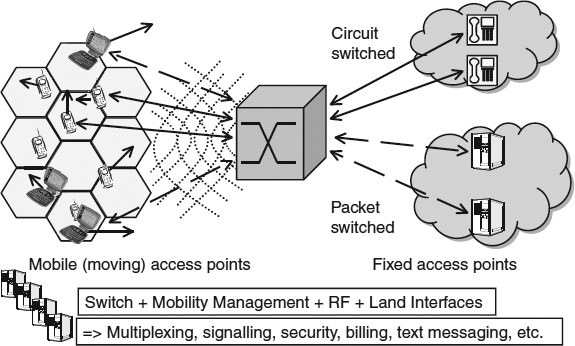12.1 THE ESSENCE OF CELLULAR NETWORKS
At its simplest, the RF network layer of our mobile applications network is fundamentally a big switch. It can route information, voice or data, from fixed information appliances to moving ones, as shown in Figure 12.2, or from one moving appliance to another. Wired-data communications connections are on the fixed network side, whilst on the mobile side, the connections are made using RF.

Figure 12.2 Essence of a mobile network. (Reproduced by permission of IXI Mobile.)
The degree of movement that we are interested in supporting should ideally cover the scope of the mobile applications and services we have been considering thus far. With a mobile service, we would like user to be able to have:
The ability to interact successfully, confidently and easily with interesting and readily available content, people or devices whilst freely moving anywhere we are likely to go in conducting our usual day-to-day business and social lives.
The freedom to move anywhere (ubiquity) is our objective. We have seen that allowing voice calls to be placed anywhere at anytime has amply proven itself as a liberating service for a large number of people. Those ‘crazy’ inventors of cellular telephony have vindicated themselves and their audacity. Now, the extent to which ubiquity is important is no longer a matter for debate, but how to achieve ubiquity often is. ...
Get Next Generation Wireless Applications: Creating Mobile Applications in a Web 2.0 and Mobile 2.0 World, 2nd Edition now with the O’Reilly learning platform.
O’Reilly members experience books, live events, courses curated by job role, and more from O’Reilly and nearly 200 top publishers.

